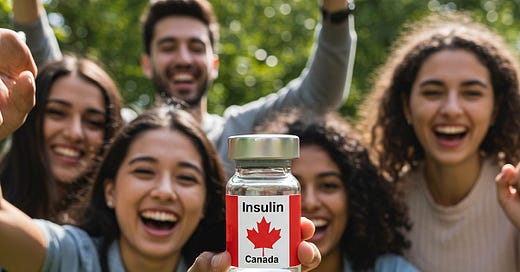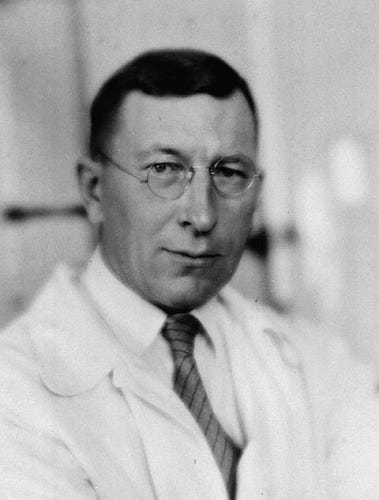Well, its a little early, but the merry month of May was when Banting and Best started the research into what was to become the discovery of insulin.
That’s the biggest bottle of insulin I’ve ever seen!
And we all know what that meant, but there’s so much more to the story.
It was on May 17, 1921 Frederick Banting and medical student Charles H. Best began their experiments at the University of Toronto.
But that’s not exactly where it began.
Let’s go back even further to 1889, when German physiologists Oskar Minkowski and Joseph von Mering discovered that removing the pancreas from dogs resulted in diabetes, indicating the pancreas' role in blood sugar regulation. But that’s not all the pancreas does—it’s complicated.
That was the real beginning. That crude approach to experimentation on dogs had implications for the next stage of research, and it wasn’t the greatest for the dogs.
Even more fascinating, in early 1900 researchers identified the islets of Langerhans in the pancreas as the source of the crucial substance, named after the German physician Paul Langerhans who mentioned these in 1869. Don’t forget at this time that of all the different cells within the 1-million-or-so islets within the pancreas, they hadn’t yet discovered the beta cells that produce insulin. They hadn’t discovered insulin yet.
And then World War One happened.
According to the Canadian Encyclopedia, Frederick Banting was a “quiet, unremarkable medical student.” 1 That’s not the full story.
He was not impressed by his medical education—the class of 1917, which graduated early in 1916, was condensed into a shorter final year—doctors were urgently needed abroad to serve in the First World War.
He worked in England in military hospitals as a medical officer, where he became more interested in surgery and research. In 1918, he was sent to France and saw “heavy action,” which means it must have been a horrific experience. He was wounded in September at Cambrai, having been hit by shrapnel. Captain Banting, while recovering in England, received the Military Cross medal for “valour under fire.”
Sir Frederick Banting circa 1931
On October 31, 1920, after having returned to Canada in 1919 and opening a medical practice in London ( you can visit this house), Dr. Frederick G. Banting noted his initial idea for isolating the internal secretion of the pancreas to treat diabetes in his journal.
Banting and medical student Charles H. Best were begrudgingly (so the story goes) given an old laboratory and access to test dogs at the University of Toronto by the department head, John Macleod in November 1920. Macleod was not impressed by the idea, or by Banting who was to carry out the research, but figured it was worth trying.
On May 17, 1921, Banting and Best began their experiments at the University of Toronto, working through the summer to carry out the painstaking research.
The pancreatic secretion was a guess—at the time it was considered a long shot. After the supply of dogs dwindled, they had to figure out how to do the experiments better. Banting had Best find more dogs around Toronto and later used pancreases from cattle at the local butcher to create a substance to inject into de-pancreatized dogs. And they sadly used a lot of dogs. It clearly wasn’t pretty nor very sanitary research, and Macleod, having been reluctant to allow Banting to conduct the research in the first place, probably regretted his decision shortly after given they didn’t agree on much.
Banting’s hunch about a pancreatic secretion, however, would later lead to the discovery of insulin, thus literally bringing children back from the dead. At the time before 1922, a diabetes diagnosis was—literally—a death sentence, as there was no cure and no effective treatment beyond strict diets that temporarily prolonged life. The children in the hospitals around the world were wasting away as they starved to death. A year or so was the blunt prognosis. While insulin was no miracle cure, it was surely one of the most stunning examples of what medical science could achieve:
Unless one has studied the case reports one can have no conception of the dramatic impact of the production of purified insulin. Diabetics placed on starvation diets, were reduced to emaciation and were barely able to hang on to a miserable life. With regular injections of insulin they could absorb and utilise a normal diet, gain weight, regain their vigour and flourish mentally and physically. 2
Not to spoil the next chapters of the story—you know what happened, mostly, but here’s a Canadian Heritage Minute for some dramatic context, but this isn’t the full story:
Next, part 2 of a the 3-part series THANK CANADA for INSULIN!
But you'll have to wait until July 30, 1921, when the first successful pancreatic extract was administered to a diabetic dog, lowering its blood sugar. The extract was later called "Isletin."
I mean July 30, 2025. We're talking history here! Back to our regularly scheduled programming next week.
Sir Frederick Banting (2025) The Canadian Encyclopedia. https://www.thecanadianencyclopedia.ca/en/article/sir-frederick-grant-banting
Botting, J. H. (2015) R.M. Botting (ed.) Animal Experiments and the Production of Insulin in Animals and Medicine: The Contribution of Animal Experiments to the Control of Disease, Open Book Publishers, https://www.jstor.org/stable/j.ctt15m7ng5.18







